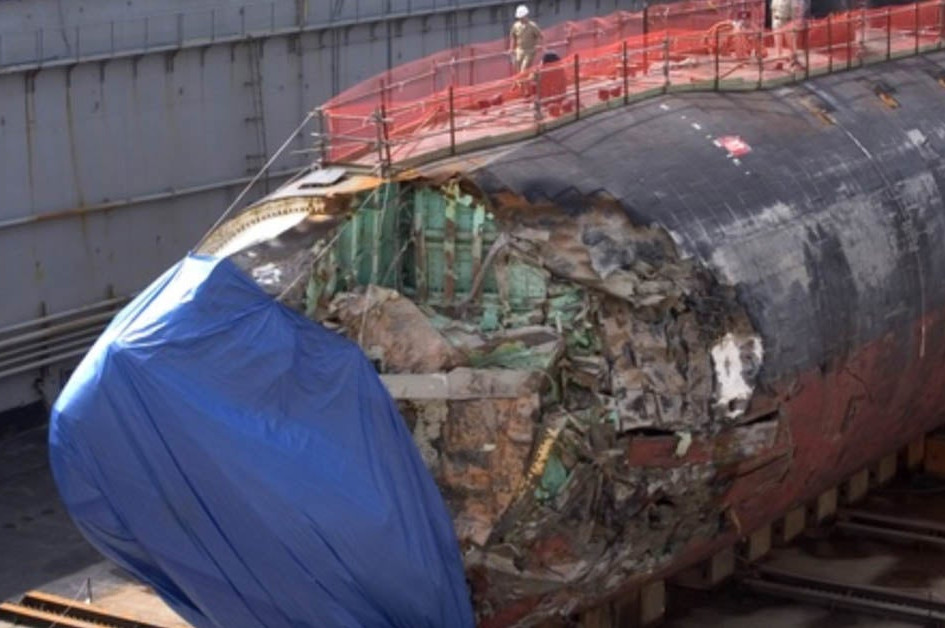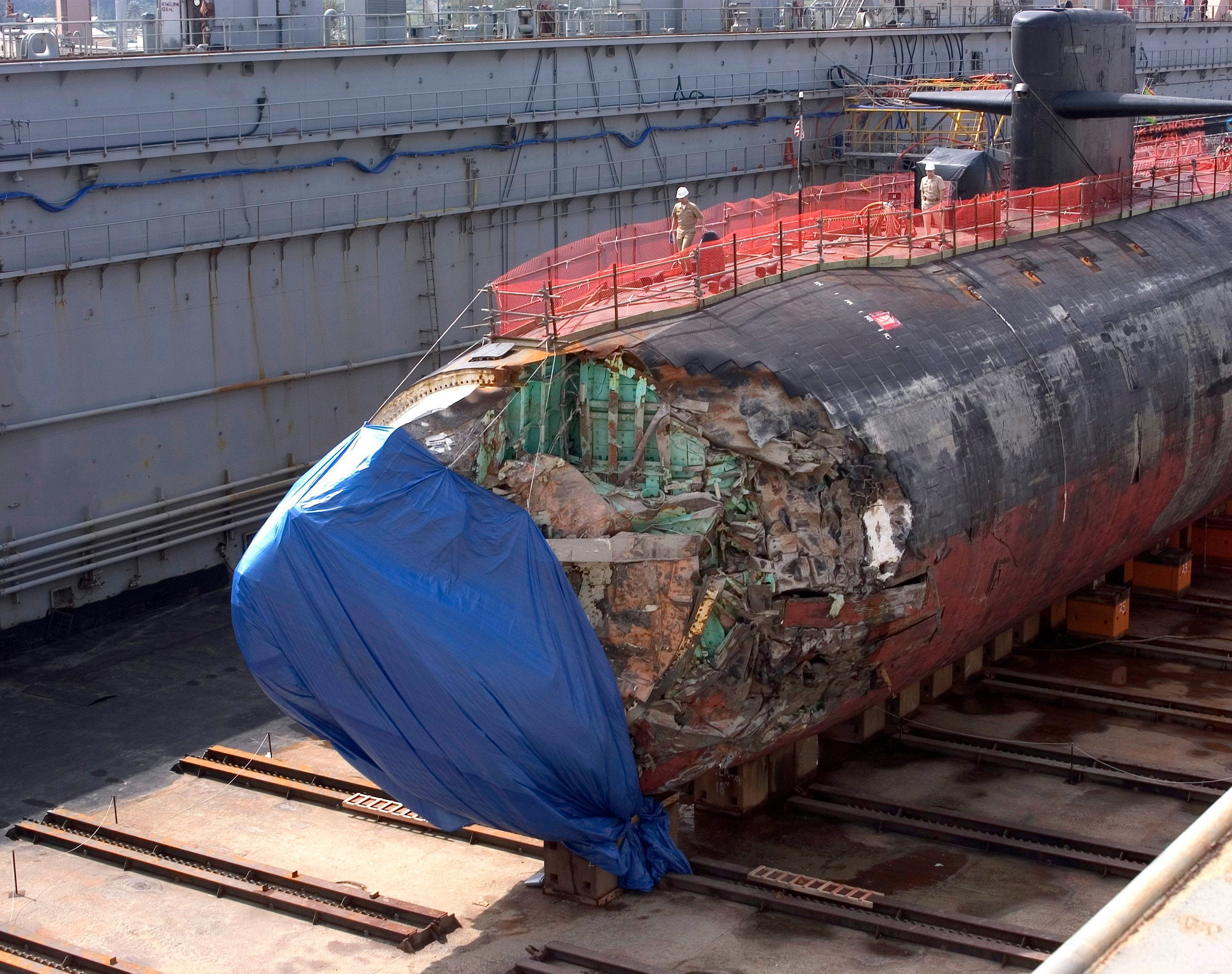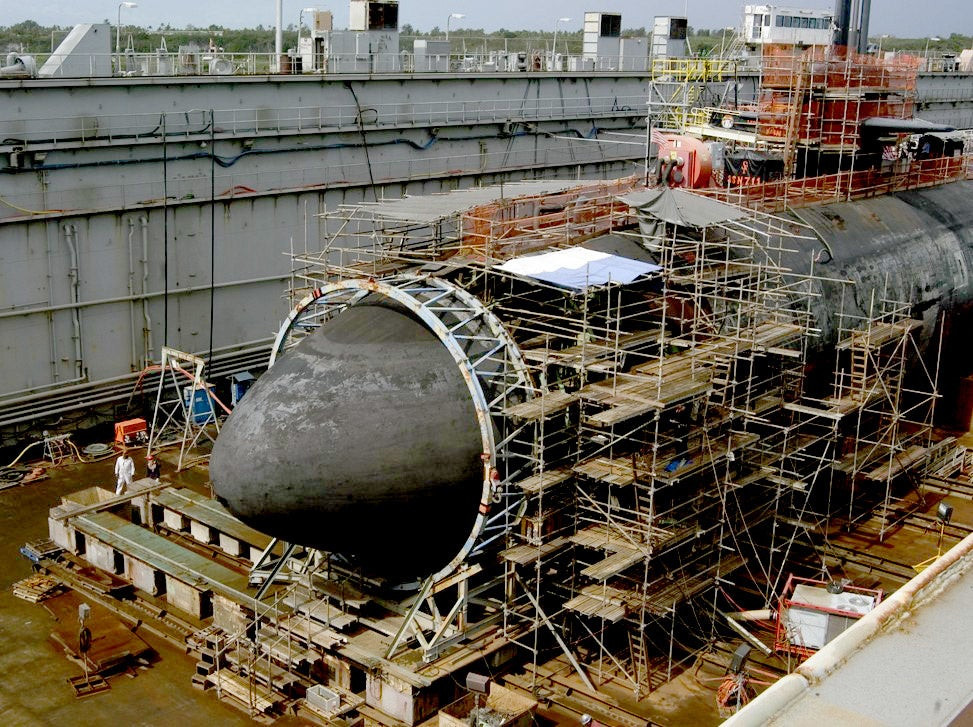
OVERVIEW
MANAGEMENT
PERFORMANCE
POSSIBILITIES
CAPITALS
ACTIVITIES
ACTORS
BURGESS
|
MILITARY ... US NAVY
THE SUBMARINE SERVICE What happens to the crew of a submarine when it crashes? Heroes are injured and some can die. This still brings tears to my eyes. 
The USS San Francisco in drydock after the collision. (U.S. Navy photo by Photographer’s Mate 2nd Class Mark Allen Leonesio) Original article: https://www.wearethemighty.com/popular/submarine-runs-into-undersea-mountain/ Burgess COMMENTARY As a child, my dream was to join the Royal Navy. My family used to take me to the Navy Days at Devonport (near Plymouth) to see the ships and all sorts of military activities. I remember walking around the British battleship HMS Vanguard soon after it had returned from carrying the Royals somewhere ... I think South Africa, but that might not be right. I also remember seeing HMS Amethyst in a terribly damaged state after it had escaped from the Communists as they were taking over Shanghai and trapped the ship in the Yangtze River. How the damaged ship got from China back to the UK seemed like a miracle! I also got to go inside a submarine and I remember how cramped it was. (See story: https://en.wikipedia.org/wiki/Amethyst_Incident ) As an adult, I always think of President Carter with respect as a submariner. In this phase of his life, President Carter was not an armchair hero, but a lot more. Peter Burgess | ||
|
What happens to the crew of a submarine when it crashes?
Heroes are injured and some can die. This still brings tears to my eyes. Written by Timothy Folliett USN (SS) Cold War Veteran March 10th 2022 On 8 January 2005 at 0243 GMT, the USS San Francisco (SSN-711) collided with an undersea mountain about 364 nautical miles southeast of Guam while operating at flank (maximum) speed at a depth of 525 feet. The collision was so serious that the vessel was almost lost—accounts detail a desperate struggle for positive buoyancy to surface after the forward ballast tanks were ruptured. Twenty-three crewmen were injured, and 24 year old Machinist's Mate Second Class Joseph Allen Ashley, of Akron, Ohio, died on 9 January from head injuries. Other injuries to the crew included broken bones, lacerations, and a back injury. San Francisco’s forward ballast tanks and her sonar dome were severely damaged, but her inner hull was not breached, and there was no damage to her nuclear reactor. She surfaced and accompanied by the USCGC Galveston Island (WPB-1349), USNS GYSGT Fred W. Stockham (T-AK-3017), and USNS Kiska (T-AE-35), as well as MH-60S Knighthawks and P-3 Orion maritime patrol aircraft, arrived in Guam on January 10th. I didn't know Joey Ashley, but he was a Submariner just like me and many of my Shipmates. The crew was just like the crew on every one of the 5 submarines I served on. Their efforts saved the USS SAN FRANCISCO and prevented further loss of life. What happened to USS SAN FRANCISCO and MM2(SS) Ashley could have happened to me, or any one of us who wear the Dolphins and go down to the sea in vessels intentionally designed to sink. It's a dangerous business whether you are underway operating as the SAN FRANCISCO was, or sitting in a dry dock like the USS MIAMI was. There are reasons it is called 'hazardous duty'. We all know the hazards and risks every time we go on board, but we do it because that is the life we choose. So on this anniversary of this tragic accident let us pause and remember Joey Ashley who gave his life while serving his country in Submarines. And let us all give thanks that we were fortunate that USS SAN FRANCISCO was not lost and that we are not remembering 127 men instead. 'There is a port of no return where ships may ride at anchor for a little space. And then some starless night the cable slips leaving only an eddy at the mooring place. Gulls veer no longer. Sailor rest your oar. No tangled wreckage will be washed ashore'. HAND SALUTE Shipmate Ashley . . . Rest Your Oar! Written by Blake Stilwell Posted On July 27, 2021 23:05:00 Just after noon on Jan. 8, 2005, the USS San Francisco, U.S. Navy nuclear-powered Los Angeles-class submarine collided with an undersea mountain while moving at maximum speed. The crew, most of them injured, one of them killed, fought for their lives to get the ship afloat. Someone messed up big time. The ship was moving at its top submerged speed, anywhere from 20-25 miles per hour. While this may not seem like much, it was more than 6,000 tons of nuclear-powered ship ramming into a mountain, enough to cause significant structural damage, ground the boat, and heavily damage its ballast tanks and sonar dome. 
The USS San Francisco in drydock after the collision. (U.S. Navy photo by Photographer’s Mate 2nd Class Mark Allen Leonesio) To say that the collision injured 98 people and killed one is somewhat misleading. That is what happened. With a complement of 118 and 12 officers, the ship had 98 injured, 80 of whom were seriously injured and/or bleeding significantly. One sailor, 24-year-old Machinist’s Mate Second Class Joseph Allen Ashley was killed by his injuries. The sailor who was able to pull the “chicken switches” (handles that force the submarine to immediately surface – an “emergency blow”) did it with two broken arms. Once the switches are pulled, the submarine’s ballast tanks are supposed to fill with high-pressure air, making the sub positively buoyant (up to two million pounds lighter) and pop above the surface of the water. 
The USS San Francisco in drydock after the collision. (U.S. Navy photo by Photographer’s Mate 2nd Class Mark Allen Leonesio) But the San Fransisco didn’t immediately pop up. For a full 60 seconds, she waited before moving to the surface. That may not seem like a lot of time, but it probably felt like forever while waiting to see if your boat was also going to be your underwater tomb. But she did surface. Later, the boat’s engineers were able to rig the auxiliary diesel engine to use the exhaust to keep the damaged ballast tanks full, and after making temporary repairs in Guam, she was able to move to Pearl Harbor. A Navy investigation found the ships crew were not using the most up-to-date charts to plot their course. The charts it did use, however, noted the presence of “discolored water,” which was indicative of a seamount. The latest charts did indicate the mountain, though, and the commander should have had the latest charts. Further, when operating in stealth, Navy submarines don’t use active sonar, and the sub was going too fast for the passive sonar to be effective. 
The Los Angeles-class submarine USS San Francisco shown in dry dock is having repairs made on its damaged bow. A new large steel dome about 20 feet high and 20 feet in diameter was put in the place of the damaged bow. (U.S. Navy) The ship was still salvageable. After being moved to Puget Sound, her bow was replaced with that of the USS Honolulu, which was being retired later that same year. The San Francisco is now a training ship for the Navy nuclear engineering school in Charleston, South Carolina. The captain, Cmdr. Kevin Mooney was relieved of his command following the collision, and six other sailors were reprimanded with him, receiving reductions in rank. For the rest of the crew, their quick response to accidentally ramming a mountain at sea and saving the ship along with their own lives while heavily injured, earned them medals from on high. MORE ON WE ARE THE MIGHTY
| The text being discussed is available at | https://www.wearethemighty.com/popular/submarine-runs-into-undersea-mountain/ and |